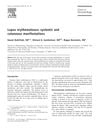Clinical Features, Etiologic Factors, Treatment, and Comorbidities of Palmoplantar Pustulosis: A Retrospective Single-Center Study
September 2019
in “
Journal of Investigative Dermatology
”

TLDR Smoking and certain health conditions like thyroid disease may make palmoplantar pustulosis harder to treat.
In a retrospective study at Severance Hospital, Seoul, Korea, involving 262 patients with palmoplantar pustulosis (PPP), 57.3% were female with an average age of 46.3 years at onset. A notable 63.7% had a history of smoking, and at diagnosis, 35.1% had nail involvement, 14.9% had arthralgia, and 24.4% had conditions like psoriasis. Comorbidities included hypertension (20.9%), type 2 diabetes (17.5%), and thyroid disease (12.2%). Most patients (96%) were treated with topical corticosteroids, while 17.1% underwent phototherapy, and 53.4% were given systemic agents. Palmoplantar distribution, nail involvement, and smoking history were significant predictors for systemic treatment use, and these factors, along with thyroid disease, were also predictors for a more stubborn disease course, requiring more than 2 systemic therapies. The study highlighted smoking history as a significant factor for a more challenging PPP course and the prevalence of comorbid conditions, emphasizing the need for comprehensive patient care and education.




